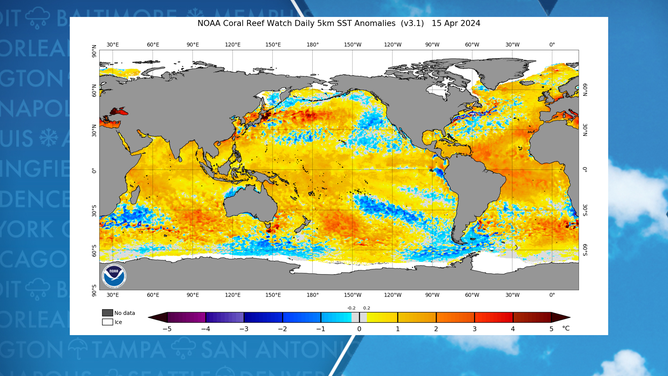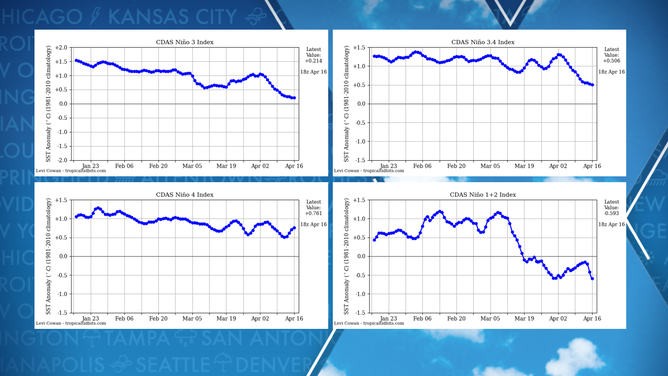Australia declares El Nino over in tropical Pacific
While NOAA is still maintaining that El Niño conditions cling to life in the tropical Pacific Ocean, Australia’s Bureau of Meteorology, which does its own analysis, said Tuesday that its latest measurements indicate ocean conditions no longer meet the El Niño threshold.
Rare 'Super El Nino' forecast to give way to La Nina
Climate scientist Tom DiLiberto explains how a La Nina could produce a more active hurricane season. Feb. 9, 2024.
While NOAA is still maintaining that El Niño conditions cling to life in the tropical Pacific Ocean, several climate organizations have declared the first El Niño event since 2019 to be over.
El Niño conditions are considered when sea-surface temperature anomalies reach 0.5 degrees Celsius (0.9 degrees Fahrenheit) above average in critical parts of the eastern and central Pacific.
During NOAA’s last update on April 11th, the agency said that while there is an 85% chance of El Niño ending this spring and there are signs in the atmospheric patterns that El Niño’s influence was fading, sea-surface temperature anomalies were still above the El Niño threshold.
EL NIÑO LIKELY IN FINAL WEEKS AS WORLD AWAITS LA NIÑA AND POTENTIAL JOLT TO HURRICANE SEASON
Australia’s Bureau of Meteorology, which does its own analysis, said Tuesday that its latest measurements indicate ocean conditions no longer meet the El Niño threshold.

Current water temperature anomalies across the globe.
(NOAA)
When ocean temperature anomalies remain in the 0.5 degrees Celsius to -0.5 degrees Celsius range, it’s considered a "neutral" pattern.
This past winter, ocean temperatures climbed to at least 2.0 degrees Celsius (3.6 degrees Fahrenheit), which pushed the event into "super El Niño" status.
The strong El Niño was credited with propelling global temperatures into record territory, creating significant droughts in parts of Asia and South America and leading to a much milder winter for parts of North America.
The exact status of the El Niño-Southern Oscillation, or what is commonly referred to as the ENSO, is vital for global climate patterns, which can impact everything from wildfires to hurricanes.

Water temperature anomalies in the eastern and central Pacific
(FOX Weather)
NOAA recently said that not only are there high odds of transitioning out of an El Niño into a neutral status before the end of spring, but a 60% chance of returning to a La Niña state by late summer.
Climate experts with Australia’s Bureau of Meteorology said they anticipate releasing an updated ENSO outlook later this year.
The bureau said ENSO-neutral years follow El Niños about 50% of the time, while La Niñas take place around 40% of the time after the demise of an El Niño.
NOAA is scheduled to issue its next update on the status of El Niño on May 9.
WHAT ARE EL NINO AND LA NINA CLIMATE PATTERNS?
Weather impacts from a neutral-ENSO event
The eventual exit out of an El Niño into a neutral status will likely not mean any immediate weather changes for North America, but the FOX Forecast Center will be watching for impacts on the upcoming summer and hurricane season.
According to historical NOAA data, all occurrences of neutral events over the last two decades have produced summers that had above-average temperatures.
The neutral-ENSO summer of 2019 was the hottest season on record for North America, with record heat experienced along both the West and East coasts.

Temperature rankings during the neutral-ENSO summer of 2019.
(FOX Weather)
The impacts of the ENSO status on hurricanes are well documented but do occasionally throw curveballs at forecasters.
Neutral years have run the gamut from just a handful of storms to being one of the most active seasons on record.
Forecasters consider 2005 to have been a year dominated by neutral conditions – 28 named storms formed, of which 15 turned into hurricanes and seven reached major status with winds of at least 115 mph.

La Niña hurricane season impacts.
(FOX Weather)
Hurricanes experts at Colorado State University expect neutral conditions to quickly transition into a La Niña climate pattern by the time the heart of the season arrives in September, which tends to be more favorable to hurricanes in the Atlantic Basin.
During La Niña events, water temperature anomalies in the central and eastern Pacific fall to below -0.5 degrees Celsius, causing warm water to accumulate in regions such as the Atlantic Ocean, Gulf of Mexico and Caribbean Sea.
Editor’s note: This story has been updated to clarify that NOAA still considers El Niño conditions to be in effect because of the different reporting methods used by NOAA and Australia's Bureau of Meteorology.
